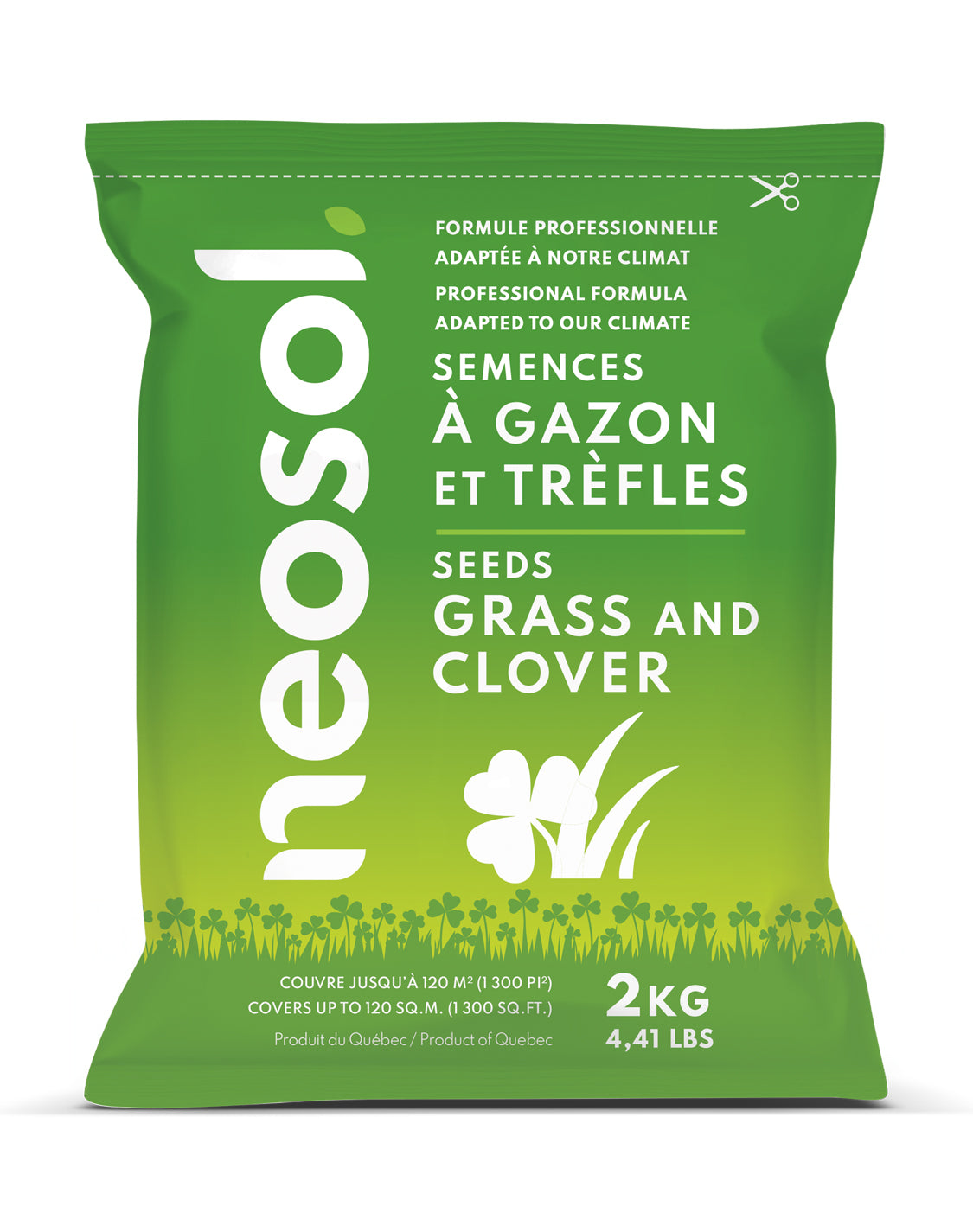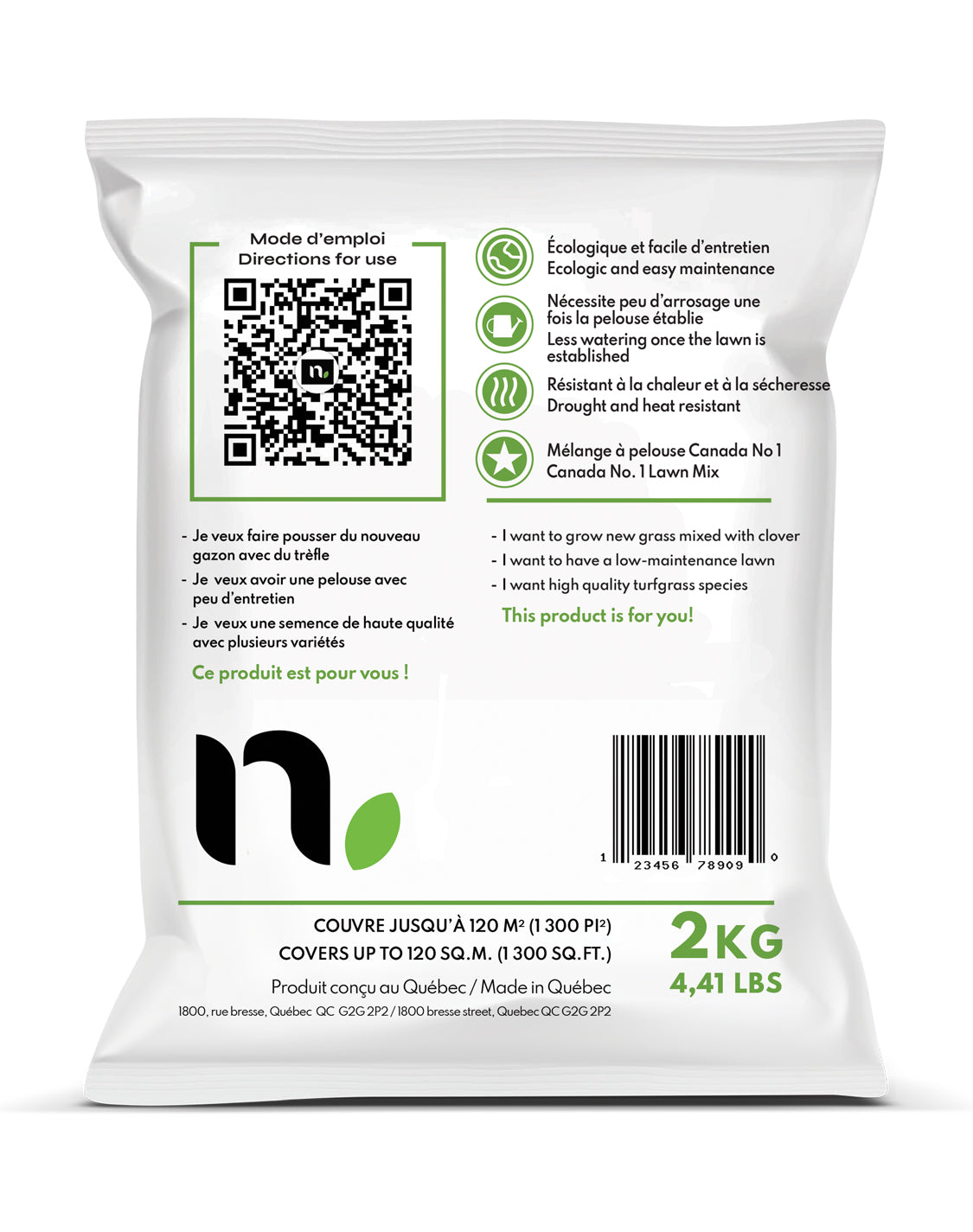Neosol Lawncare
Grass seed and clover - 2kg
Grass seed and clover - 2kg
Couldn't load pickup availability
 Eco-friendly and easy to maintain
Eco-friendly and easy to maintain
 Requires little watering once lawn is established
Requires little watering once lawn is established
 Heat and drought resistant
Heat and drought resistant
- Perfect for very sunny or very shady locations.
- Perfect for having an easy to maintain plot
Description
Neosol grass seed and clover allows you to obtain a new dense lawn that is very resistant , no matter the location. Whether in sunny places or under trees in the shade , your lawn will be more resistant to trampling and drought . In addition, a dense lawn reduces the presence of weeds . Having micro pipolina clover makes the lawn easier to maintain . Clover does not need much water and always retains its green color even during dry periods . The mixture is composed of the best seeds in terms of quality.
Blanket
New seed coverage : 2 kg covers 75 m2 / 810 ft2
Reseeding coverage: 2 kg covers 120 m2 / 1300 ft2
Mélange
Mélange
Recipe
45% Starlett Tall Fescue
20% Esquire Perennial Ryegrass
17% Kentucky Bluegrass SR2100
10% Brahms Grass Fescue
5% Dumas 1 hard fescue
3% Pipolina Microclover
Utilisation
Utilisation
Repairing dead grass patches / Repairing dead grass patches
- Mow the lawn very short, about 2 in.
- Rake yellowed or damaged lawn
- Pull out as many weeds as possible
- Spread a 1/2-inch thick layer of seed compost over the entire desired surface.
- Spread the seeds evenly.
- Add a layer of potting soil about 1/4 inch over the entire surface.
- Keep the soil moist until the lawn is established (without waterlogging), for about 20 days. The spray should be gentle so as not to wash away the seeds.
- Mow the lawn when it is about 4 inches tall.
Re-seed and overseed
Reseeding helps increase the density of your lawn and reduce weed growth.
- Aerate the soil (ideally)
- Mow the lawn very short, about 5 cm (2 in)
- Pull out as many weeds as possible.
- Spread the seeds evenly, making sure they come into contact with the soil.
- Keep the soil moist until the lawn is established (without saturating it with water), for about 20 days.
Seeding a new lawn
- Clear the surface of any debris.
- Spread a 4 to 6 inch layer of potting soil over the entire surface-Spread the seeds evenly.
-Add a layer of potting soil about 1/4 inch over the entire surface.
-Keep the soil moist until the lawn is established (without it being saturated with water), for about 20 days. The jet must be weak so as not to carry away the seeds.
-Mow the lawn when it has reached a height of approximately 4 inches.
Livraison
Livraison
Gratuite avec tout achat de 125$ et plus.
Partager


FAQ
What makes grass and clover seed different from other seeds?
1. Tolerance to varied conditions:
Sun and Shade: The combination of grasses allows this seed to adapt well to various light conditions, including sunny and shaded areas.
Drought Tolerance: Starlett Tall Fescue and Pipolina Microclover are particularly drought tolerant, allowing the lawn to remain green and healthy even in arid conditions.
2. Speed of establishment:
Esquire Perennial Ryegrass: Fast germination (5-10 days), providing rapid initial ground cover.
Pipolina Microclover: Contributes to rapid and dense coverage, improving weed resistance.
3. Resilience and robustness:
Starlett Tall Fescue: Good tolerance to trampling and difficult conditions, ideal for lawns used frequently.
Kentucky Bluegrass SR2100: Excellent resistance to heat and water stress, contributing to the durability of the lawn.
4. Improving soil quality:
Pipolina Microclover: Nitrogen fixing capacity, enriching the soil naturally and reducing the need for chemical fertilizers.
5. Turf health and density:
Creeping Red Fescue Maxima and Hard Fescue Dumas 1: Good resistance to diseases and shade, contributing to a dense and healthy lawn.
Brahms Turf Fescue: Strengthens turf density, reducing weed growth and improving the overall appearance of the lawn.
When to sow?
Spring :
When?: From mid-April to mid-June.
Advantages: The soil warms up, and temperatures are moderate, which promotes rapid germination and good growth of young plants. In addition, spring rains help keep the soil moist.
Disadvantages: Competition with weeds may be more intense, and regular watering may be necessary if the spring is dry.
Late summer to early fall:
When?: From mid-August to the end of September.
Pros: Temperatures are still warm, but nights are getting cooler, creating ideal conditions for grass germination and establishment. There is generally less competition from weeds, and the soil stays moist thanks to fall rainfall.
Disadvantages: Time for establishment before winter sets in is limited, so it is crucial to sow early enough to allow young plants to root.
By seeding in spring or late summer, you give your lawn the best chance to establish and thrive.
How to sow a new lawn?
- Clear the surface of any debris.
- Spread a 4 to 6 inch layer of potting soil over the entire surface
-Spread the seeds evenly.
-Add a layer of potting soil about 1/4 inch over the entire surface.
-Keep the soil moist until the lawn is established (without it being saturated with water), for about 20 days. The jet must be weak so as not to carry away the seeds.
-Mow the lawn when it has reached a height of approximately 4 inches.
How to seed a new lawn or overseed?
- Aerate the soil (ideally)
- Mow the lawn very short, about 5 cm (2 in)
- Pull out as many weeds as possible.
- Spread the seeds evenly, making sure they come into contact with the soil.
- Keep the soil moist until the lawn is established (without saturating it with water), for about 20 days.
How to repair dead grass patches / repair dead grass patches?
- Mow the lawn very short, about 2 in.
- Rake yellowed or damaged lawn
- Pull out as many weeds as possible
- Spread a 1/2-inch thick layer of seed compost over the entire desired surface.
- Spread the seeds evenly.
- Add a layer of potting soil about 1/4 inch over the entire surface.
- Keep the soil moist until the lawn is established (without it being saturated with water), for about 20 days. The jet must be weak so as not to carry away the seeds.
- Mow the lawn when it has reached a height of approximately 4 inches.
How to use grass seed with other products?
Seed should be applied 5 to 7 days after using a herbicide. Herbicide should not be applied to new seedlings until four weeks after seeding. Fertilizer can be applied before, during, or after seeding. Insecticide can be applied before, during, or after seeding.
How long does it take before you see the first blades of grass?
With the composition of the grass and clover seed, germination times vary depending on the different grass and clover species included. Here is an overview of typical germination times for each type of seed in this mix:
Starlett Tall Fescue (45%): 10 to 14 days
Esquire perennial ryegrass (20%): 5 to 10 days
Kentucky Bluegrass SR2100 (17%): 14 to 21 days
Brahms Grass Fescue (10%): 7 to 14 days
Dumas 1 hard fescue (5%): 10 to 14 days
Pipolina Microclover (3%): 7 to 14 days
Estimated first shoots:
Since perennial ryegrass has the shortest germination time, you can expect to see the first perennial ryegrass shoots appear in about 5 to 10 days after sowing. Other species will follow:
Perennial ryegrass: 5 to 10 days
Grass fescue, hard fescue, tall fescue and microclover: 7 to 14 days
Kentucky Bluegrass: 14 to 21 days
Conclusion :
You should start seeing the first shoots of your grass and clover in about 5 to 10 days, mainly due to the rapid germination of perennial ryegrass. Other species, including fescues and microclover, will follow shortly after, in 7 to 14 days, while Kentucky bluegrass will take the longest, with visible shoots in 14 to 21 days.






